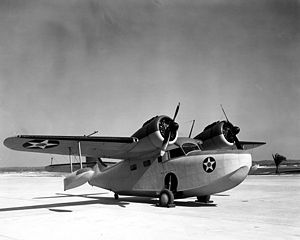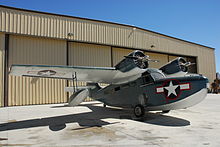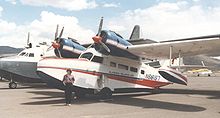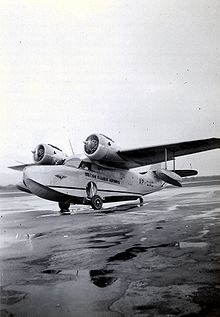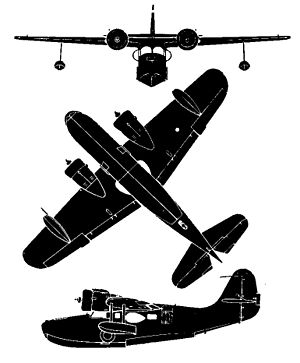- Grumman G-21 Goose
-
G-21 Goose Role Transport amphibious aircraft Manufacturer Grumman First flight 1937 Primary users United States Navy
United States Army Air Forces
Royal Air Force
Royal Canadian Air ForceNumber built 345 Unit cost $62,180.00 USD for JRF-6B (1942) The Grumman G-21 Goose amphibious aircraft was designed as an eight-seat "commuter" plane for businessmen in the Long Island area. The Goose was Grumman’s first monoplane to fly, its first twin-engined aircraft, and its first aircraft to enter commercial airline service. During World War II, the Goose became an effective transport for the US military (including the Coast Guard), as well as serving with many other air forces. During hostilities, the Goose took on an increasing number of combat and training roles. The adaptable transport continued in postwar use.
Contents
Design and development
In 1936, a group of wealthy residents of Long Island, including E. Roland Harriman, approached Grumman and commissioned an aircraft that they could use to fly to New York City.[1] In response the Grumman Model G-21 was designed as a light amphibian transport. Grumman’s typically rugged engineering produced a high-winged monoplane of almost all-metal construction - the trailing half of the main wing and all of the flight control surfaces except for the flaps were fabric-covered. It was powered by two 450 horsepower (340 kW) Pratt & Whitney R-985 Wasp Jr. nine-cylinder, air-cooled, radial engines mounted on the leading edges of the wings. The deep fuselage served also as a hull and was equipped with hand-cranked retractable landing gear. First flight of the prototype took place on May 29, 1937.[2]
The fuselage also proved versatile as it provided generous interior space that allowed fitting for either a transport or luxury airliner role. Having an amphibious configuration also allowed the G-21 to go just about anywhere, and plans were made to market it as an amphibian airliner.[3]
Modifications
There were a number of modifications of the Goose, but the most numerous were those by McKinnon Enterprises of Sandy, Oregon, who had twenty-one supplemental type certificates (STCs) for modifying G-21 series aircraft and who also manufactured four different conversions that were re-certified under a separate FAA type certificate (TC no. 4A24) as brand new "McKinnon" airplanes.[4] The first was the McKinnon model G-21C which involved replacing the original R-985 radial engines with four Lycoming GSO-480-B2D6 piston engines. It was approved under TC 4A24 on November 7, 1958 and two examples were built in 1958-1959.
The second McKinnon conversion was the model G-21D, which differed from the G-21C only by the insertion of a 36-in. extension in the nose section of the aircraft in front of the cockpit, and 12-in. extensions that were added to the horizontal stabilizers and elevators. The extended nose of the G-21D was distinguishable by the addition of two new windows on each side and it housed four additional passenger seats. Only one G-21D was built and it was actually re-converted from the very first G-21C. When later converted to turbine engines, it was nicknamed "Turboprop Goose."
After the turbine conversion of the G-21D, McKinnon developed an STC (SA1589WE) to install the same 550 shp Pratt & Whitney Canada PT6A-20 engines on Grumman G-21A aircraft that were still certified under TC no. 654. Two G-21A aircraft were modified as “Hybrid” turbine conversions, one by Marshall of Cambridge in the UK (using McKinnon STC kits shipped over from Oregon) and one belonging to the Bureau of Land Management, an agency of the US Department of the Interior in Alaska was modified by McKinnon in 1967. Because they also had many other McKinnon features installed on them using some of his STCs, these aircraft were later confused with similar but subsequent McKinnon turbine conversions and model G-21E aircraft, but they actually remained “Grumman G-21A” aircraft under TC no. 654; they were never officially re-certified under McKinnon’s TC 4A24.
In addition to the two G-21A “Hybrid” turbine conversions, in 1968 McKinnon converted two other G-21A aircraft to a turbine configuration and he claimed that they were simultaneously re-certified as models G-21C under TC 4A24, Section I, and as turbines per STC SA1320WE. However, it appears that they lacked some of the internal structural reinforcements that were part of the model G-21C design and that were unrelated to the turbine engine transplant from the four Lycoming GSO-480 series piston engines, as a result of which, they were certified to operate up to a maximum gross weight of only 10,500 lbs. McKinnon dubbed these aircraft model G-21C “Hybrids” but one year after they were built, their configuration was approved by the FAA as a whole new model under TC 4A24.
The third McKinnon model, the G-21E, was based on his previous G-21C “Hybrid” conversions. It was initially certified with the same two 550 shp Pratt & Whitney Canada PT6A-20 turboprops used on the G-21D turbine conversion, but later, after approval of the model G-21G, 680 shp (507 kW) PT6A-27 engines were approved as an option on the G-21E. Only one example was ever actually built and re-certified as a model G-21E and it was, in fact, equipped with the more powerful PT6A-27 engines.
The final McKinnon variant was the G-21G, which was approved by the FAA on August 29, 1969 under Section IV of TC no. 4A24. The G-21G combined all of the structural reinforcements and 12,500-lb gross weight of the earlier G-21C and D models, as well as their other features such as the “radar” nose, the “wrap-around” windshield, retractable wing-tip floats, and “picture” cabin windows, with the more powerful PT6A-27 turbine engines and other minor details to produce the ultimate McKinnon Goose conversion.
New production
In November 2007, Antilles Seaplanes of Gibsonville, North Carolina announced it was restarting production of the turbine-powered McKinnon G-21G Turbo Goose variant, now identified as the Antilles G-21G Super Goose.[1] PWC PT6A-34 turboprops flat-rated to 680 shp (507 kW) will replace the original PWC PT6A-27 engines,[1] and the airframe systems and especially the avionics (aviation electronics – i.e. radios and navigation systems) will be updated with state-of-the-art equipment, including in the not too distant future, new “glass panel” instrumentation and cockpit displays. The first example is now being assembled.[1]
Operational history
 Goose of the Royal Air Force
Goose of the Royal Air Force
Envisioned as corporate or private "flying yachts" for Manhattan millionaires, initial production models normally carried two to three passengers and had a bar and small toilet installed. As well as being marketed to small air carriers, the G-21 was also promoted as a military transport. In 1938, the US Army Air Force purchased the type as the OA-9 (later, in the war years, examples impressed from civilian ownership were designated the OA-13A). The most numerous of the military versions were the United States Navy variants, designated the JRF.
The amphibian was soon adopted by the Coast Guard and, during World War II, it also served with the RCAF in the transport, reconnaissance, rescue and training roles. The G.21 was used for air-sea rescue duties by the Royal Air Force (RAF). The RAF, in a common naming convention with all of its aircraft, designated the type as "Goose."
On returning to civilian service, after the war, the Goose found continued commercial use in locations from the wilderness of Alaska to the sunny climes of Catalina.
A total of 345 were built, with about 30 still airworthy today (although more like 60 are still on various civil registries, many of them are known to have crashed or been otherwise destroyed), most being in private ownership, some of them operating in modified forms.[5]
Variants
- G-21
- Original production version, powered by two 450 hp (336 kW) Wasp Junior SB engines, 7,500 lb (3,400 kg) gross weight. Six passengers. Twelve built, all converted to G-21A standards.[6]
- G-21A
- Increased gross weight (8,000 lb (3,636 kg)). Thirty built.[6]
- G-21B
- Export coastal patrol flying boat. Armed with .30 in machine gun in bow and dorsal hatches and two 100 lb (45 kg) bombs underwing. Twelve built for Portuguese Naval Aviation.[6]
- G-21C
- Conversion by McKinnon Enterprises, re-engined with four 340 hp (254 kW) Lycoming GSO-480-B2D6 air-cooled, geared, and supercharged flat-six engines and fitted with retractable wing-tip floats, a fiberglass “radar” nose, a one-piece “wrap-around” windshield, and “picture” (enlarged) cabin windows. Gross weight increased to 12,499 lb (5,669 kh) as result of internal structural reinforcements. Two converted as piston-powered models G-21C (serial nos. 1201 and 1202) in 1958-1959. Two other airframes subsequently converted in 1968, but with two 550 shp (579 eshp, 432 kW) Pratt & Whitney Canada PT6A-20 turboprops per STC SA1320WE as G-21C “Hybrids” (serial nos. 1203 and 1204.) The two G-21C “Hybrids” were actually identical to the later 10,500 lb model G-21E, but they were never certified as such. [7]
- G-21D
- One G-21C further converted by McKinnon with extended bow section marked by two extra windows on each side and accommodating another four passengers (serial no. changed from 1201 to 1251 in conjunction with re-certification as model G-21D in June 1960.) In 1966, it was re-engined with two 550 shp (579 eshp, 432 kW) Pratt & Whitney Canada PT6A-20 turboprops and fitted with revised Alvarez-Calderon electric flaps in accordance with STC SA1320WE, retaining the G-21D designation but subsequently identified as a McKinnon “Turboprop Goose.”[8]
- G-21E
- Fully-certified new model based on simplified turbine conversion of McKinnon model G-21C, with 550 shp PT6A-20 engines (680 shp PT6A-27 engines optional) and more fuel, but without all of the structural reinforcements of the 12,499 lb model G-21C. 10,500 lb (4,763 kg) gross weight. One converted (serial no. 1211.) [4]
- G-21F
- Conversion by Fish & Wildlife Service in Alaska (using McKinnon engineering data) with 715 shp (533 kW) Garrett TPE331-2UA-203D turboprops. One converted but the FWS model “G-21F” was never approved by the FAA and the one example that was built was inexplicably re-certified as a supposedly modified McKinnon G-21G in spite of the fact that it was not built by McKinnon nor ever conformed to the model G-21G type design. [9]
- G-21G
- Final McKinnon conversion also fully certified as a new model with 680 shp (507 kW) PT6A-27 engines, 586 US gal. of fuel, and 12,500 lb gross weight. Two converted (serial nos. 1205 and 1226.) [7]
- XJ3F-1
- Prototype eight seat utility amphibian for US Navy. One built 1938.[6][10]
- JRF-1
- Production version of XJ3F-1. Five built for US Navy.[6]
- JRF-1A
- Similar to JRF-1, but with target towing gear and camera hatch added. Five built for US Navy.[6]
- JRF-2
- Version for United States Coast Guard, with provision for carrying stretchers. Seven built.[6]
- JRF-3
- Similar to JRF-2, but fitted with autopilot and deicing boots on wing leading edge to aid operations in Arctic. Three built for Coast Guard.[6][11]
- JRF-4
- Similar to JRF-1A, but could carry two depth bombs under wing. Ten built for US Navy.[6]
- JRF-5
- Major production version, incorporating bomb racks from JRF-4, target towing and camera gear from JRF-1A and de-icing gear from JRF-3. 184 built.[6]
- JRF-5G
- 24 JRF-5 transferred to US Coast Guard.[6][11]
- JRF-6B
- Navigation trainer purchased for supply under Lend-Lease. 50 built.[6]
- OA-9
- Transport and air-sea rescue amphibian for United States Army Air Forces. Twenty-six ordered in 1938, supplemented by five JRF-6Bs carrying the same designation.[6][11]
- OA-13A
- Designation given to three G-21As impressed by USAAF.[6][12]
- OA-13B
- Two JRF-5s transferred to USAAF.[6][12]
- Goose Mk I
- British designation for three JRF-5s supplied to the Fleet Air Arm.[13]
- Goose Mk IA
- British designation for 44 JRF-6Bs supplied under Lend Lease and used for Observer training by 749 Naval Air Squadron in Trinidad.[13]
- Goose Mk II
- British designation for two JRF-5s used as staff transports by British Air Commission in United States and Canada.[13]
- Grumman LXG
- A single Grumman G.21A evaluated by the Imperial Japanese Navy Air Service .[citation needed]
Operators
Military operators
- Royal Australian Air Force
- Six aircraft were used by No. 1 Air Ambulance Unit RAAF in Mediterranean.
- Paraguayan Naval Aviation
- United States Army Air Corps
- United States Army Air Force
- United States Navy
- United States Coast Guard
Governmental operators
- The Fish and Wildlife Service and the Bureau of Land Management, both agencies of the US Department of the Interior in Alaska, each operated several G-21 aircraft.
Civil operators
- Asiatic Petroleum
- British Guiana Airways
- Air BC
- Almon Landair Ltd
- European Coastal Airways
- H.J. O'Connell Supplies
- Oakley Air Ltd Canada
- Pacific Coastal Airlines
- Sioux Narrows Airways
- West Coast Air Services
- Koninklijke Nederlandsch-Indische Luchtvaart Maatschappij
- Yaukuve Resort
- Mount Cook Airline
- Sea Bee Air
- Alaska Coastal Airlines
- Alaska Coastal-Ellis Airlines
- Alaska Island Air
- Alaska Fish and Game
- Amphib. Inc.
- Antilles Air Boats
- Avalon Air Transport
- Catalina Air
- Catalina Channel Airlines
- Chevron of California
- Devcon Construction
- Flight Data Inc.
- Ford Motor Co.
- Gulf Oil
- Kodiak Airways
- Kodiak Western
- North Coast Aero
- Ozark Management
- Pan Air
- PenAir
- Reeve Aleutian Airways
- SouthEast Skyways
- Superior Oil
- Sun Oil Co. (Sunoco)
- Teufel Nurseries
- The Texas Company (Texaco)
- Tuthill Corporation
- Virgin Islands Seaplane Shuttle
- Webber Airlines
Accidents and incidents
- On June 22, 1972, N1513V of Reeve Aleutian Airways was written off at False Pass, Alaska.[15][16]
- On September 2, 1978, Charles F. Blair, Jr., former Naval Air Transport Service and Pan American Airways pilot and husband to actress Maureen O'Hara was flying a Grumman Goose that belonged to his company, Antilles Air Boats, from St. Croix to St. Thomas in the US Virgin Islands when it crashed into the ocean due to engine failure. He and three passengers were killed, seven passengers were severely injured.
- On August 3, 2008, a Grumman Goose of Pacific Coastal Airlines with seven passengers and crew crashed during a flight from Port Hardy to Chamiss Bay. The aircraft was completely destroyed by a fire. There were only two survivors.[17]
- On November 16, 2008 a Grumman Goose of Pacific Coastal Airlines with eight passengers and crew crashed during a flight from Vancouver International Airport to Toba Inlet, BC. The aircraft exploded into a mass of burning wreckage according to the lone survivor. This person was rescued up by the Coast Guard on South Thormanby Island off British Columbia's Sunshine Coast. The company resumed floatplane operations on November 19, 2008.[18]
- On February 27, 2011 a turbine Goose, N221AG, crashed in the United Arab Emirates when it immediately veered after takeoff. Although registered in the US as a McKinnon G-21G, the aircraft was not an actual McKinnon conversion; it was instead actually designed and built by the Fish & Wildlife Service in Alaska, who originally intended it to be re-certified as a model G-21F, but that design was never formally approved as such by the FAA. [19]
Specifications (JRF-5 Goose)
Data from United States Navy Aircraft since 1911 [20]
General characteristics
- Crew: one–three
- Capacity: five–seven passengers
- Length: 38 ft 6 in (11.74 m)
- Wingspan: 49 ft 0 in (14.94 m)
- Height: 16 ft 2 in (4.93 m)
- Wing area: 375 ft² (34.9 m²)
- Airfoil: Root: NACA 23015, Tip: NACA 23009
- Empty weight: 5,425 lb (2,466 kg)
- Loaded weight: 8,000 lb (3,636 kg)
- Useful load: 2,575 lb (1,170 kg)
- Max takeoff weight: 8,000 lb (3,636 kg)
- Powerplant: 2 × Pratt & Whitney R-985-AN-6 Wasp Junior nine-cylinder air-cooled radials, 450 hp (340 kW) each
Performance
- Maximum speed: 201 mph (175 knots, 324 km/h) at 5,000 ft (1,520 m)
- Cruise speed: 191 mph (166 knots, 308 km/h) at 5,000 ft (1,520 m)
- Range: 640 mi (557 nmi, 1,030 km)
- Service ceiling: 21,300 ft (6,494 m)
- Rate of climb: 1,100 ft/min (5.6 m/s)
- Wing loading: 21.3 lb/ft² (104 kg/m²)
- Power/mass: 0.11 hp/lb (0.19 kW/kg)
Armament
- Bombs: 2 x 325-lb depth charges or 2 x 250-lb GP bombs[21]
Notable appearances in media
The Grumman Goose has been featured in films and television. A U.S. Navy JRF-1 Goose in early World War II paint scheme appears in full color close-up water-taxiing and climbing a ramp in the 1943 submarine film Crash Dive.
In the 1967 film Tobruk starring Rock Hudson and George Peppard, Maj. Donald Craig (Hudson) is rescued from Vichy forces in Algeria by a team of Jewish commandos posing as Nazis and led by Capt. Kurt Bergman (Peppard). They make their get-away in a silver Grumman Goose painted with Nazi crosses and they go on to sabotage German defenses and fuel stores near Tobruk in conjunction with an Allied amphibious assault there.[22]
A Grumman Goose with Pan Air’s retractable wing-tip float modification appears in the motion picture Commando (1985).
A Goose named Cutter's Goose is prominent in the 1980s TV series Tales of the Gold Monkey starring Stephen Collins, inspired by the movie Only Angels Have Wings.
In the Quantum Leap TV series (1992), during the Ghost Ship episode Sam Beckett leaps into a pilot tasked with flying a converted VIP carrying Grumman Goose through the dangers of the Bermuda Triangle to save a critically ill passenger and mentally unstable co-pilot.
In Jimmy Buffett's first novel, Where is Joe Merchant?, protagonist Frank Bama owned and operated a rebuilt Grumman Goose dubbed the Hemisphere Dancer. (The actual Hemisphere Dancer is a Grumman Albatross that belongs to Buffett and is now the centerpiece for his Margaritaville Cafe restaurant in Orlando, Florida.)[citation needed]
A Grumman Goose with a luxurious interior appears in the first episode of the third season of the animated FX network series Archer.
See also
- Related development
- Related lists
- List of seaplanes and amphibious aircraft
References
- Notes
- ^ a b c d "Goose." Antilles Seaplanes history page. Retrieved: August 30, 2008.
- ^ "Grumman Goose." Aerofiles.com Grumman page. Retrieved: August 30, 2008.
- ^ Truelson 1976
- ^ a b [1] FAA Type Certificate no. 4A24. Retrieved: August 26, 2011.
- ^ "Seven confirmed dead in B.C. plane crash." canada.com. Retrieved: December 19, 2009.
- ^ a b c d e f g h i j k l m n o Francillon and Killion 1993, p.55.
- ^ a b [2] FAA Registry – Aircraft – N-Number Inquiry. Retrieved: August 26, 2011.
- ^ Francillon and Killion 1993, pp. 54–56.
- ^ [3] or [4] National Digital Library: Home. Retrieved: June 10, 2009.
- ^ Green 1968, pp. 169–170.
- ^ a b c Donald 1995, p.145.
- ^ a b Green 1968, p.169.
- ^ a b c March 1998, p.127.
- ^ "Grumman Goose has served coast for many years as 'flying-boat workhorse'." canada.com. Retrieved: December 19, 2009.
- ^ "N1513V." NTSB. Retrieved: December 19, 2009.
- ^ "accident." NTSB. Retrieved: December 19, 2009. Note: States 1970 as year!?
- ^ "5 dead in B.C. plane crash." TheGlobeAndMail.com. Retrieved: December 19, 2009.
- ^ "7 dead in plane crash off B.C. coast." CBC News, November 16, 2008. Retrieved: December 19, 2009.
- ^ "Plane crash kills 4 in UAE" CNN News, February 28, 2011. Retrieved: February 28, 2011.
- ^ Green 1968, p.171.
- ^ [5] Tobruk (1967). Retrieved: August 26, 2011.
- Bibliography
- Donald, David, ed. American Warplanes of World War II. London: Aerospace Publishing, 1995. ISBN 1-874023-72-7.
- Francillon, René J. and Gary L. Killion. "Sauce for the Goose - turbine style". Air International, July 1993, Vol. 45, No 1, pp. 53–57. Stamford, UK:Key Publishing. ISSN 0306-5634.
- Green, William. War Planes of the Second World War: Volume Five Flying Boats. London:Macdonald, 1968. ISBN 0-356-01449-5.
- March, Daniel J., ed. British Warplanes of World War II. London: Aerospace Publishing, 1998. ISBN 1-874023-92-1.
- Swanborough, Gordon and Peter M. Bowers. United States Navy Aircraft since 1911. London: Putnam, Second edition, 1976. ISBN 0-370-10054-9.
- Thruelsen, Richard. The Grumman Story. New York: Praeger Publishers, Inc., 1976. ISBN 0-275-54260-2.
- Winchester, Jim, ed. "Grumman Goose/Mallard." Biplanes, Triplanes and Seaplanes (The Aviation Factfile). Rochester, Kent, UK: Grange Books plc, 2004. ISBN 1-84013-641-3.
External links
- Grumman Goose at the Smithsonian
- Goose Central/ Biggest database on the Grumman Goose in the world
- Antilles Seaplanes - Home of the G-21G Super Goose
Grumman and Northrop Grumman aircraft Manufacturer
designationsG-1 (floats only) · G-2 (floats only) · G-3 · G-4 · G-5 · G-6 · G-7 · G-8 · G-9 · G-10 · G-11 · G-12 · G-13 · G-14 · G-15 · G-16 · G-17 · G-18 · G-19 · G-20 · G-21 · G-22 · G-23 · G-24 · G-25 · G-26 · G-27 · G-29 · G-30 · G-31 · G-32 · G-33 · G-34 · G-35 · G-36 · G-37 · G-38 · G-39 · G-40 · G-41 · G-42 · G-43 · G-44 · G-45 · G-46 · G-47 · G-48 · G-49 · G-50 · G-51 · G-52 · G-53 · G-54 · G-55 · G-56 · G-57 · G-58 · G-59 · G-60 · G-61 · G-62 · G-63 · G-64 · G-65 · G-66 · G-67 · G-68 · G-69 · G-70 · G-71 · G-72 · G-73 · G-74 · G-75 · G-76 · G-77 · G-78 · G-79 · G-80 · G-81 · G-82 · G-83 · G-84 · G-85 · G-86 · G-87 · G-88 · G-89 · G-90 · G-91 · G-92 · G-93 · G-94 · G-96 · G-97 · G-98 · G-98J · G-99 · G-100 · G-101 · G-102 · G-103 · G-104 · G-105 · G-106 · G-107 · G-108 · G-109 · G-110 · G-111 · G-112 · G-113 · G-114 · G-115 · G-116 · G-117 · G-118 · G-119 · G-120 · G-121 · G-122 · G-123 · G-124 · G-125 · G-126 · G-127 · G-128 · G-134 · G-159 · G-164 · G-191 · G-231 · G-234 · G-251 · G-262 · G-303 · G-426 · G-712 · G-1128 · G-1159
By role Piston fightersJet fightersF9F · F9F/F-9 · XF10F · F11F/F-11/F11F-1F · G-118 · F-111B · F-14
Attack/PatrolRecon/ScoutsUtility/TransportsCivil aircraftMallard · Ag Cat · Kitten · Tadpole · Gulfstream I · Gulfstream II
OthersApollo Lunar Module · EF-111 · X-29 · Q-8 · X-47A · X-47B
By name Ag Cat · Albatross · Avenger · Bearcat · Cougar · Duck · Fifi · Goose · Greyhound · Guardian · Gulfhawk III · Gulfstream I · Gulfstream II · Hawkeye · Hellcat · Intruder · Jaguar · Kitten · Mallard · Mohawk · Panther · Pegasus · Prowler · Skyrocket · Super Tiger · Tadpole · Tiger · Tigercat · Tomcat · Tracer · Tracker · Trader · Wildcat · Widgeon
USAAC/USAAF observation aircraft Observation O-1 • O-2 • XO-3 • XO-4 • O-5 • O-6 • O-7 • O-8 • O-9 • XO-10 • O-11 • O-12 • O-14 • XO-14 • XO-15 • XO-16 • O-17 • XO-18 • O-19 • YO-20 • XO-21 • O-22 • YO-23 • O-24 • O-25 • Y1O-26 • Y1O-27 • O-28 • O-29 • O-30 • O-31 • O-32 • Y1O-33 • O-34 • O-35 • XO-36 • O-37 • O-38 • O-39 • O-40 • Y1O-41 • O-42 • O-43 • XO-44 • O-45 • O-46 • O-47 • XO-48 • O-49 • YO-50 • YO-51 • O-52 • O-53 • YO-54 • YO-55 • O-56 • O-57 • O-58 • O-59 • O-60 • XO-61 • O-62 • XO-63
Observation Amphibian USN/USMC utility aircraft designations 1935–1955 Utility Stearman-HammondJHJK · J2K
JLLockheedJOFairchildFordJW · J2W
Utility transport SikorskyJapanese Navy Transport Aircraft designations Swedish Air Force military aircraft designations 1940–present B/S/T/Tp 16 - Sk 16 • B/S 17 • B/S/T 18 • J 19 • J 20 • A/J 21 • J/S 22 • J 23 • B/J 24 - Tp 24 • Sk 25 • Sk 26 - B/S 26 - J/S 26 • J 27 • A/J/Sk 28 • A/J/S 29 • J 30 • S 31 • A/J/S 32 • J 33 • J 34 • J/S/Sk 35 • A 36 • AJ/JA 37 • A/Sk 38 • JAS 39 • Tp 45 • Tp 46 • Tp 47 • Sk 50 • Fpl 51 • Tp 52 • Tp 53 • Fpl 54 - Tp 54 • Tp 55 • Sk 60 • Sk/Fpl 61 • Tp 78 • Tp 79 • Tp 80 • Tp 81 • Tp 82 • Tp 83 • Tp 84 • Tp 85 • Tp 86 • Tp 87 • Tp 88 • Tp 89 • Tp 91 • Tp 100 • Tp 101 • Tp 102 • Tp 103
Lists relating to aviation General Aircraft (manufacturers) · Aircraft engines (manufacturers) · Airlines (defunct) · Airports · Civil authorities · Museums · Registration prefixes · Rotorcraft (manufacturers) · TimelineMilitary Accidents/incidents Records Categories:- Seaplanes and flying boats
- Amphibious aircraft
- World War II utility aircraft of the United States
- United States civil utility aircraft 1930–1939
- United States military utility aircraft 1930–1939
- United States Coast Guard Aviation
- Grumman aircraft
Wikimedia Foundation. 2010.

